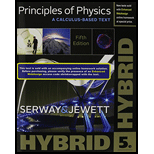
Concept explainers
(a)
The angle of refraction for the sound wave.
(a)
Answer to Problem 4P
The angle of refraction for sound wave is
Explanation of Solution
Given info: The wavelength of sound wave is
The speed of sound in air at
The expression for the Snell’s law is,
Here,
Rearrange the above formula to find
The formula to calculate speed of sound in water is,
Here,
Substitute
Substitute
Conclusion:
Therefore, the angle of refraction for the sound wave is
(b)
The wavelength of sound in water.
(b)
Answer to Problem 4P
The wavelength of sound in water is
Explanation of Solution
Given info: The wavelength of sound wave is
The formula to calculate the wavelength is,
Here,
Rearrange the above formula to find
Substitute
Conclusion:
Therefore, the wavelength of sound in water is
(c)
The angle of refraction.
(c)
Answer to Problem 4P
The angle of refraction is
Explanation of Solution
Given info: The wavelength of sodium yellow light is
The formula to calculate the Snell’s law is,
Here,
Rearrange the above formula to find
Substitute
Conclusion:
Therefore, the angle of refraction is
(d)
The
(d)
Answer to Problem 4P
The wavelength of light in water is
Explanation of Solution
Given info: The wavelength of sodium yellow light is
The formula to calculate the wavelength is,
Here,
Rearrange the above formula to find
Substitute
Conclusion:
Therefore, the wavelength of light in water is
(e)
The behavior of sound and light waves.
(e)
Answer to Problem 4P
The behavior of sound and light waves is that the sound waves speeds up when travelling from rarer medium to denser medium and light rays slows down.
Explanation of Solution
Given info: The wavelength of sodium yellow light is
The medium that has low refractive index with respect to another medium is called rarer medium and the medium that has high refractive index with respect to another medium is called denser medium.
From part (b) the wavelength of sound wave in water is larger than the wavelength of sound in air and from part (d) the wavelength of light in water is less than the wavelength of light in air.
The sound waves travelling from rarer to denser medium then the refracted sound waves bend away from the normal that the reason there is an increase in wavelength of sound waves.
The ray of light travelling from rarer to denser medium then the refracted rays bends towards the normal. So that’s the reason there is a decrease in the wavelength of light in water.
Conclusion:
Therefore, The behavior of sound and light waves is that the sound waves speeds up when travelling from rarer medium to denser medium and light rays slows down.
Want to see more full solutions like this?
Chapter 25 Solutions
Principles of Physics: A Calculus-Based Text, Hybrid (with Enhanced WebAssign Printed Access Card)
- Hi! I need help with these calculations for part i and part k for a physics Diffraction Lab. We used a slit width 0.4 mm to measure our pattern.arrow_forwardExamine the data and % error values in Data Table 3 where the angular displacement of the simple pendulum decreased but the mass of the pendulum bob and the length of the pendulum remained constant. Describe whether or not your data shows that the period of the pendulum depends on the angular displacement of the pendulum bob, to within a reasonable percent error.arrow_forwardIn addition to the anyalysis of the graph, show mathematically that the slope of that line is 2π/√g . Using the slope of your line calculate the value of g and compare it to 9.8.arrow_forward
- An object is placed 24.1 cm to the left of a diverging lens (f = -6.51 cm). A concave mirror (f= 14.8 cm) is placed 30.2 cm to the right of the lens to form an image of the first image formed by the lens. Find the final image distance, measured relative to the mirror. (b) Is the final image real or virtual? (c) Is the final image upright or inverted with respect to the original object?arrow_forwardConcept Simulation 26.4 provides the option of exploring the ray diagram that applies to this problem. The distance between an object and its image formed by a diverging lens is 5.90 cm. The focal length of the lens is -2.60 cm. Find (a) the image distance and (b) the object distance.arrow_forwardPls help ASAParrow_forward
 Principles of Physics: A Calculus-Based TextPhysicsISBN:9781133104261Author:Raymond A. Serway, John W. JewettPublisher:Cengage Learning
Principles of Physics: A Calculus-Based TextPhysicsISBN:9781133104261Author:Raymond A. Serway, John W. JewettPublisher:Cengage Learning Physics for Scientists and Engineers: Foundations...PhysicsISBN:9781133939146Author:Katz, Debora M.Publisher:Cengage Learning
Physics for Scientists and Engineers: Foundations...PhysicsISBN:9781133939146Author:Katz, Debora M.Publisher:Cengage Learning University Physics Volume 3PhysicsISBN:9781938168185Author:William Moebs, Jeff SannyPublisher:OpenStax
University Physics Volume 3PhysicsISBN:9781938168185Author:William Moebs, Jeff SannyPublisher:OpenStax Physics for Scientists and Engineers with Modern ...PhysicsISBN:9781337553292Author:Raymond A. Serway, John W. JewettPublisher:Cengage Learning
Physics for Scientists and Engineers with Modern ...PhysicsISBN:9781337553292Author:Raymond A. Serway, John W. JewettPublisher:Cengage Learning Physics for Scientists and EngineersPhysicsISBN:9781337553278Author:Raymond A. Serway, John W. JewettPublisher:Cengage Learning
Physics for Scientists and EngineersPhysicsISBN:9781337553278Author:Raymond A. Serway, John W. JewettPublisher:Cengage Learning College PhysicsPhysicsISBN:9781285737027Author:Raymond A. Serway, Chris VuillePublisher:Cengage Learning
College PhysicsPhysicsISBN:9781285737027Author:Raymond A. Serway, Chris VuillePublisher:Cengage Learning





